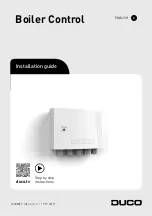
Boiler Connections
27
Installation Examples
(continued)
Pressure drop (primary circuit) of Vitodens 100-W
Typical System Flow Rates
Model
WB1A
8-24
8-30
∆
∆
∆
∆
t for NG
Output (NG)
Btu/h
72 000
90 000
20 ºF rise (GPM)
7.2
9.0
25 ºF rise (GPM)
5.8
7.2
30 ºF rise (GPM)
4.8
6.0
35 ºF rise (GPM)
4.1
5.1
40 ºF rise (GPM)
3.6
4.5
Use standard friction loss method for pipe sizing.
Observe boiler maximum and minimum flow rate limitations. If system flow rate exceeds
boiler maximum flow rate (as stated on page 68) or if system flow rate is unknown, Viessmann strongly
recommends the installation of a low-loss header. See page 36 for low-loss header information or refer to the Vitodens
Venting System Installation Instructions.
Important!
The following examples depict possible piping layouts of the Vitodens 100-W boiler equipped with Viessmann System
Technology.
Please note that the examples below are simplified conceptual drawings only!
Piping and necessary componentry must be field verified.
A low water cut-off (LWCO) must be installed where required by local codes.
Proper installation and functionality in the field is the responsibility of the heating contractor.
5
5
8
1
7
7
5
1
.3
Pressure drop for model WB1A 8-24, 8-30
0
1
2
3
4
5
6
7
8
0
3.3
6.6
9.8
13.1
16.4
19.7
23
26
S
u
p
p
ly
h
e
a
d
p
re
s
s
u
re
ft
.
m
0
2.2
4.4
6.6
8.8
11
13.2
Flow rate
15.4
1.1
0
500
1000
1500
2000
2500
3000
3500
250
ltr/h
GPM
A low-loss header
must
be used when the
system
flow rate exceeds the maximum (or minimum) flow
rate of the Vitodens 100-W boiler. An alternative
method may be used, such as primary secondary
piping using closely spaced tees.
A low-loss header offers additional benefits not
provided by a pair of closely spaced tees. Viess-
mann strongly recommends and prefers the use of
a low-loss header over closely spaced tees.
















































